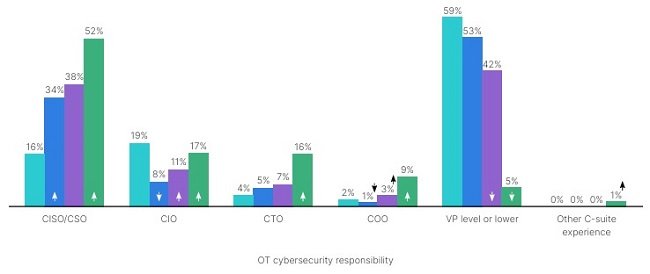As industrial systems become more interconnected and digitized, a new global report from cybersecurity leader Fortinet reveals a paradigm shift in Operational Technology (OT) cybersecurity governance. According to the 2025 State of Operational Technology and Cybersecurity Report, OT security has evolved from a backroom technical issue to a strategic priority at the executive level.
A staggering 95% of organizations now assign OT cybersecurity responsibility to C-level executives, compared to just 41% in 2022. Furthermore, 52% have appointed their CISO or CSO as the lead for OT security—a dramatic increase from only 16% three years ago.
CISOs Lead the Charge Toward Integrated IT-OT Security
The report identifies a growing trend across critical sectors such as manufacturing, energy, petrochemicals, logistics, healthcare, and utilities, where OT systems are core to day-to-day operations. In these sectors, 80% of organizations plan to place OT cybersecurity under the CISO’s domain within the next year, aiming to create unified cybersecurity strategies that span both IT and OT environments.
“Organizations are clearly taking OT security more seriously,” said Nirav Shah, Senior Vice President of Products and Solutions at Fortinet. “This shift in leadership underscores the business-critical nature of OT security and the urgency to align resources across all levels of the organization to protect these vital systems.”

Cybersecurity Maturity Drives Measurable Risk Reduction
Fortinet’s report outlines a strong correlation between higher OT cybersecurity maturity and reduced operational disruptions. The share of organizations achieving Level 1 OT maturity—characterized by robust network visibility and segmentation—has increased to 26%, up from 20% the previous year.
Most companies now operate at Level 2, with an emphasis on access control and asset profiling. Those with advanced maturity levels are showing increased resilience against threats such as phishing, advanced persistent threats (APTs), and OT-specific malware. Significantly, operational outages impacting revenue have declined from 52% to 42%, pointing to the effectiveness of enhanced cyber readiness.

Stronger Practices, Safer Systems
Adoption of cybersecurity best practices is helping organizations lower their attack surface and respond more effectively to threats. A key highlight is the drop in business email compromise (BEC) attacks, attributed to improved cyber hygiene, employee training, and proactive awareness programs.
Real-Time Defense Through Threat Intelligence Platforms
The use of threat intelligence platforms has surged by 49% since 2024, reflecting a shift toward data-driven cybersecurity. These platforms provide real-time analytics and proactive threat detection, empowering organizations to act swiftly against evolving cyber threats.

Vendor Consolidation and Platform Architectures Enhance Efficiency
Vendor consolidation emerged as another key marker of cybersecurity maturity. In 2025, 78% of organizations report using only one to four OT vendors, significantly simplifying operations. Many have embraced integrated platform architectures, like the Fortinet OT Security Platform, to unify threat detection, policy enforcement, and incident response.
The impact is profound: organizations using such platforms reported a 93% reduction in cyber incidents and a sevenfold improvement in operational performance, due to faster triage, simplified configuration, and quicker threat resolution.
The Future: IT/OT Security Operations Integration
The report emphasizes the urgent need to converge IT and OT security strategies. Recommended actions include:
- Achieving end-to-end network visibility
- Applying compensating controls to mitigate risks from vulnerable assets
- Implementing network segmentation in line with ISA/IEC 62443 standards
- Deploying AI-driven OT-specific threat intelligence for real-time mitigation
Integrating OT into broader Security Operations (SecOps) frameworks empowers organizations to respond faster to incidents and ensures cross-functional collaboration between IT and OT teams—essential in today’s high-stakes cybersecurity landscape.

Securing OT: From Optional to Essential
The message from Fortinet’s 2025 report is clear: Operational Technology security is no longer optional. It’s foundational to resilience, compliance, and competitiveness. To effectively navigate the evolving threat environment, organizations must:
- Empower executive leadership
- Modernize cybersecurity architecture
- Unify IT and OT security frameworks
In doing so, they’ll build a future-ready security posture capable of defending critical infrastructure in an increasingly digital world.
Sign up for our mailing list to receive the latest news.
Follow us also on the tech news portal in the Egypt


